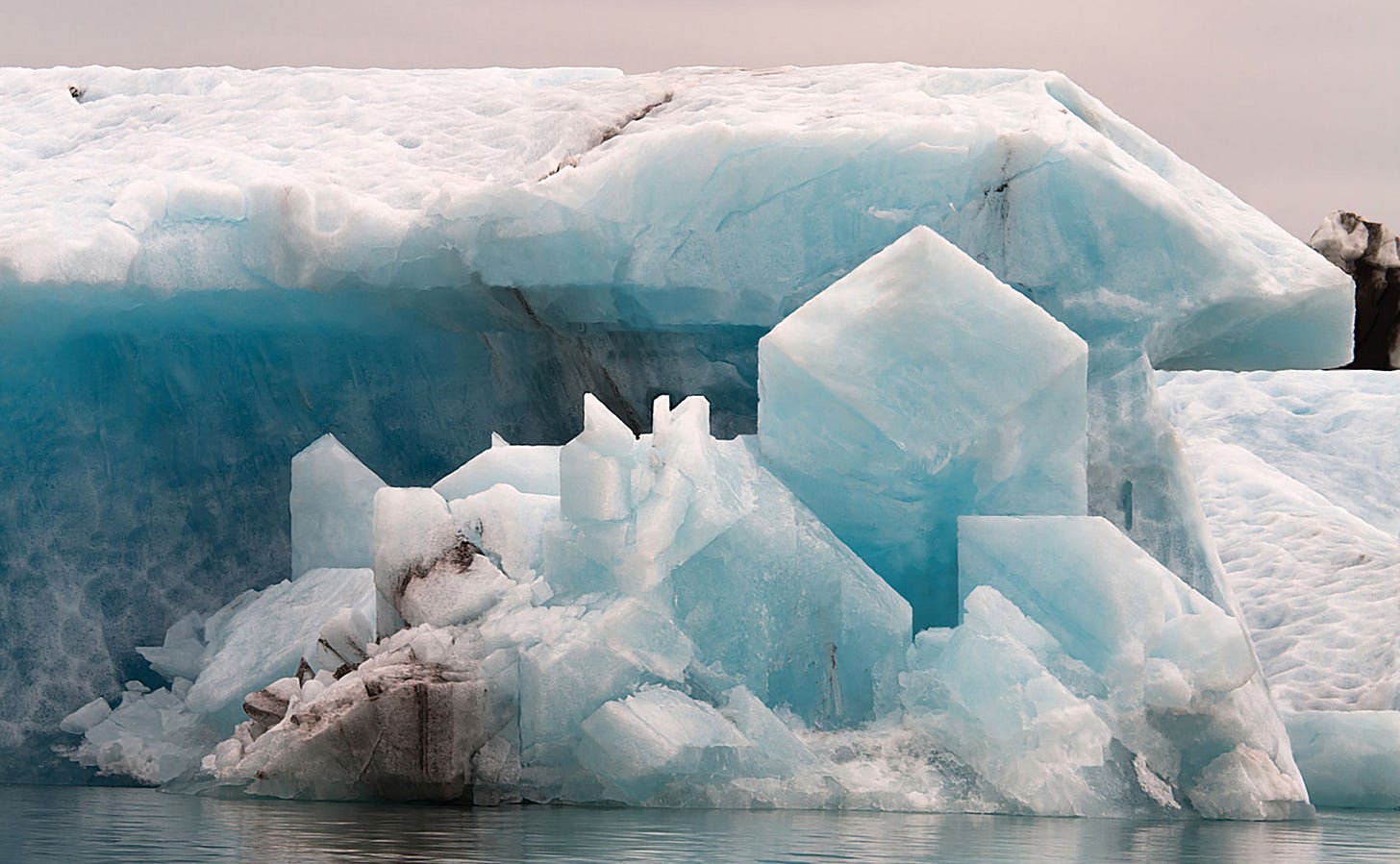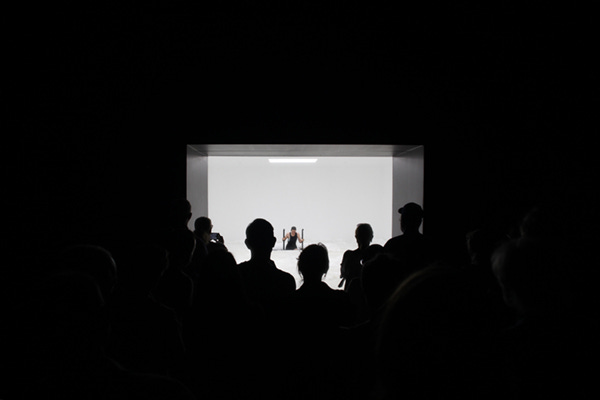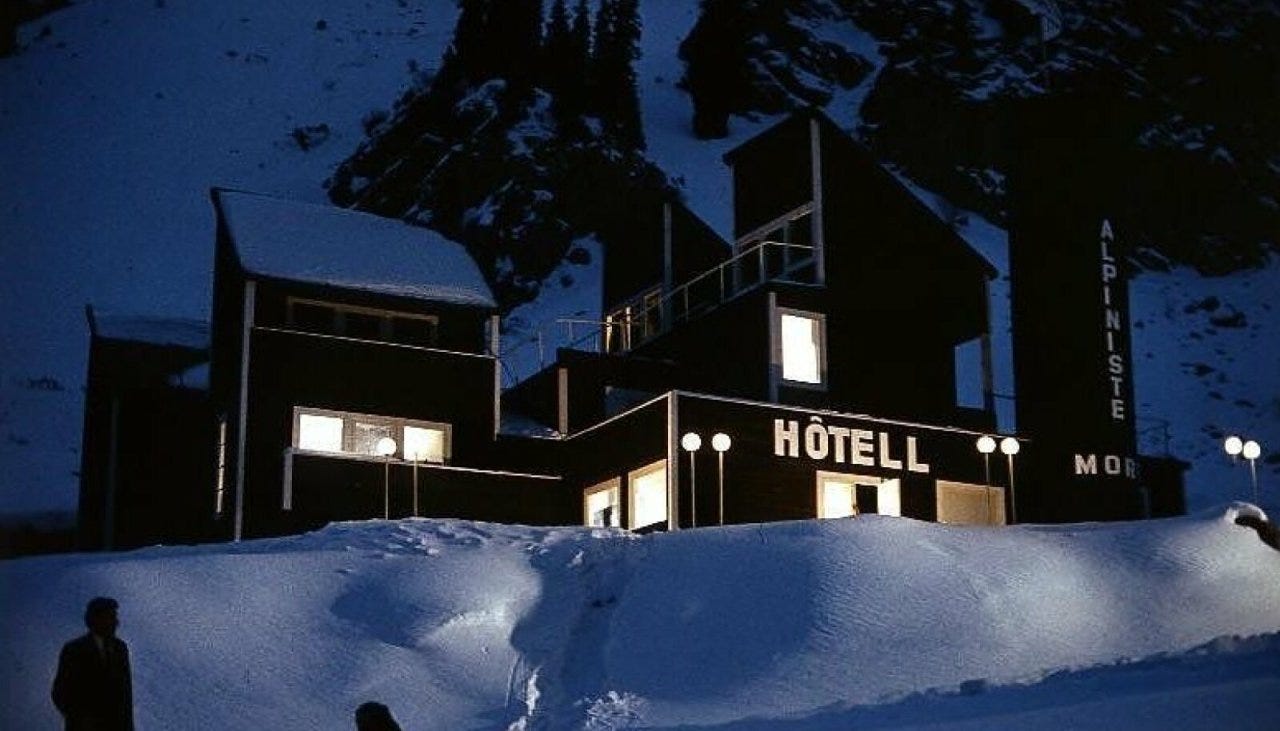037. Frostbitten Reliquary
I’ll admit, it’s a little silly that I’m drafting this newsletter sitting in my childhood bedroom in Florida, but here we are.
Hello friends,
I’ll admit, it’s a little silly that I’m drafting this newsletter sitting in my childhood bedroom in Florida, but here we are. Then there’s the added layer of irony that already, over the past two years, we’ve broken records for warmest winters across the country. As someone who didn’t grow up with snow days, or even the occasional flurry outside my window, there’s this silly little part of me that gets excited when I need to start throwing my coat on before leaving the house. Eventually, the sluggish grayness of winter will wear me down until I wake up in the morning with aches and hands eager to meet the warmth of a cup of coffee or a bowl of soup.
There’s an undeniable beauty to the cold. I can talk about the way clumps of snow catch in our hair, glitter when a stray slice of sun cuts through the clouds, about the deep blues of glacial ice, but in this moment that may chill us to the bone, there’s also a chance to find warmth in the comfort of others or the coziness of solitude.
Whether your holiday plans have been disrupted, you’re spending this time alone, or with friends and family as good or bad as that might be, I hope you take this letter as a little gift from me, something to entertain you in those few precious days when the world slows down and we all try to catch our breath.
TOUCH
A dear friend gifted me this amazing mushroom print beanie from Parks Project at the start of the month and I’m not ashamed to admit that I’ve worn it every chance I’ve had. Despite the un-seasonably warm winter New York City has had this year, it’s so cozy that I’ll risk a sweaty scalp and I can’t wait to bring it with me on next year’s outdoor adventures. Another plus? Proceeds from each Parks Project sale goes to the National Parks Conservation Association, so you’re helping support the protection of our public lands for generations to come.
LOOK
Environmental artist Basia Irland creates her Ice Books from river water collected at each site she chooses. In the process of freezing this water, these forms are filled with a collection of native seeds local to the area. The acting of reseeding is, then, a simple one: as the Ice Book is sent downstream, the melting block of ice begins to disperse seeds that wash ashore and later grow along the riverbanks. We think of books as being full of text, a permanent record of knowledge passed on from one reader to the next, yet Irland’s books are inscribed with an ecological language much older than our own. Each book’s disintegration represents complex systems of growth, multi-species community, regeneration and resilience in the shadow of environmental threats.
This 1942 woodblock print by Settai Komura, aptly titled Snowy Morning, manages to perfectly capture that sensation of heavy calm that comes with waking up to a world covered in freshly fallen snow. Looking at this, I can imagine Komura going to his window and taking note of the unblemished blanket of white in the early hours before everyone else wakes up. I love how the snow softens the angular lines of architecture. The tranquil precision of scenes like these, almost always devoid of a human presence I might add, make more sense when you know that Komura worked as a kabuki stage designer in addition to being an illustrator. Looking at Snowy Morning, you get a feeling that domestic life itself becomes like a theater.
Tabular icebergs are a curious phenomenon, precisely cubic cuts freshly splintered from the ice shelf. French artist Hugo Livet, inspired by these strangely symmetrical sheets of ice, began to manipulate royalty-free images he found online into geometric sculptures that fall somewhere between the artificial and the natural. The resulting series, titled Dérive (2018), depicts icebergs that look more like glitches in a computer game. The angular cuts and voids give a surreal edge to the human consequences of climate change.
I first learned about Taryn Simon’s 2018 installation, A Cold Hole, when I was working at the front desk of a museum. One of the visitors that day had gone to see it and told me about her experience watching from a crowd as one of MASS MoCA’s security guards came in on one of his days off to take a plunge in the installation’s frigid waters. I keep describing A Cold Hole as an installation, but there’s an element of performance in body’s violent reaction to the cold, the gasp of surprise, arms flailing from the shock, stress and endurance. Like Simon’s other body of work, this cut out in the ice, where participants can jump or slowly lower themselves into, is a culmination of interconnected histories: cold water immersions to prepare for battle, Finnish avanto swimming, icy plunges for charity fundraising, Eastern Orthodox baptisms, Shinto Kanchu Misogi ritual cleansing, or, in the case of Charles Darwin, a “water cure” designed to treat his chronic illness.
LISTEN
There’s something about Men I Trust’s music that sounds like winter to me. With their dreamy synths, slow aching melodies, and Emma Proulx’s airy vocals that feel like something out of the Twin Peaks soundtrack, there’s a cold comfort to their songs, one that makes me want to bundle up in my warmest scarf and coat and spend hours listening to them as I wander around alone in the city. I actually ended up doing just that with their new release, Untourable Album. It’s one of my favorite pieces of music to come out this year, and I still haven’t grown sick of keeping it on repeat. “Organon” and “Serenade of Water” are two of its brightest gems.
To be honest, I’ve never given much thought to what happens in bodies of water after they freeze over for the winter. Lakes, rivers, and ponds turn into temporary skating rinks, potential fishing spots, or unstable ground that’s better left alone. Yet this great episode from Outside/In takes a look at the plants and animals that call these sealed up ecosystems their home. From fish thriving in insulated waters to algae flourishing in a forgotten ecology, I left this episode with a newfound appreciation for ice.
When I first heard Overheard at National Geographic’s episode about ice stupas, I had to pull up a picture on my phone to make sure I was imagining these structures correctly. The cold, dry desert of Ladakh in the Kashmir region of India has relied on the meltwater from nearby glaciers to farm their lands for generations. Yet, with climate change and warming seasons, shrinking glaciers have led to water shortages that threaten the survival of these remote communities. Enter: the ice stupa, an artificial glacier created by Sonam Wangchuk, a mechanical engineer who continues to live in Ladakh today. Together with his students, they built a water pressure system that used the region’s cold air to freeze sprayed water in the form of a tower. One stupa ended up growing to seven feet tall and held one million liters of water that supplied water to area for months. It’s a fascinating listen, and a great example of ingenious invention under the destabilizing effects of climate change.
LICK
One of my all-time favorite cold weather movies is the 1979 Estonian film, Dead Mountaineer’s Hotel. What starts out as a fairly typical whodunnit—a detective is called to a remote hotel, only to be trapped by an avalanche with the hotel patrons (and potential murder suspects)—quickly devolves into a biting critique of Soviet nationalism through a surreal blend of science fiction and noir.
The music video for Hania Rani’s “F Major” sets its stage in the breathtaking landscape of Iceland. Against the whipping wind and a backdrop of snow-stained mountains, dancers move across the flat beaches in rhythm with nature, their footsteps marking each choreography into the sand.
“Marine snow” is a deep sea phenomenon that is (sorry to say) not actually snow. These white flakes, a microscopic composite of dead plants, sand, and decaying material, can sometimes take weeks to ‘rain’ down all the way to the bottom of the ocean floor and end up being great food sources for the creatures scavenging in the depths of our oceans. It’s crazy to think that this uncanny blizzard-like trickle of dust and organisms like algae and plankton, are helping to not only sustain these fragile underwater ecosystems but also act as a carbon sink that’s helped keep our planet cool for millennia (something now threatened by rapidly warming waters).
CLICK
As someone who grew up in a place where it never snowed, I always associated winter with fairytales—stories of seeking refuge from a storm in a mysterious cabin, mysterious creatures roaming desolate landscapes, castles glittering with ice. Claude McKay’s poem, “After the Winter,” has an element of magic to it. It’s a melodic poem that warms you, lets your fingers defrost a little bit, a gentle reminder that the dreariness of winter spill into a kinder season very soon: “We’ll turn our faces southward, love, / Toward the summer isle / Where bamboos spire the shafted grove / And wide-mouthed orchids smile.”
It’s a classic horror scenario: the remote Antarctic research center besieged by forces beyond human comprehension or, worse, the human capacity for monstrosity when left in desolate isolation. “Antarctica” by D.A. Xiaolin Spires is a refreshing take on this setting. As researchers experiment with ice, including Spires’s artist-in-residence narrator, they find their time in this unforgiving landscape increasingly disrupted by a strange species of microorganism emerging from the melting expanse.
Elizabeth Bishop's “At the Fishhouses” is one of the poems that chills you to the goddamn bone. We oftentimes associate cold with a numbness, but this whole piece is a feast for the senses. Despite the inhospitable weather, an elderly fisherman continues, reeking of cod. Bishop writes, “There are sequins on his vest and on his thumb. / He has scraped the scales, the principal beauty, / from unnumbered fish with that black old knife, / the blade of which is almost worn away.” I love this cutting image of silver, how Bishop captures that bite of freezing water: “If you tasted it, it would first taste bitter, / then briny, then surely burn your tongue.”
Thanks for taking the time to read! Feel free to share this little project of mine with your friends, lovers, and enemies. If you like what I do, you can help feed my leopard gecko through Ko-Fi or check out my website. You can find a list of books by the people I mentioned on Bookshop (I get a small commission through this and any affiliate links in this letter).
Until next time,
Ellie











